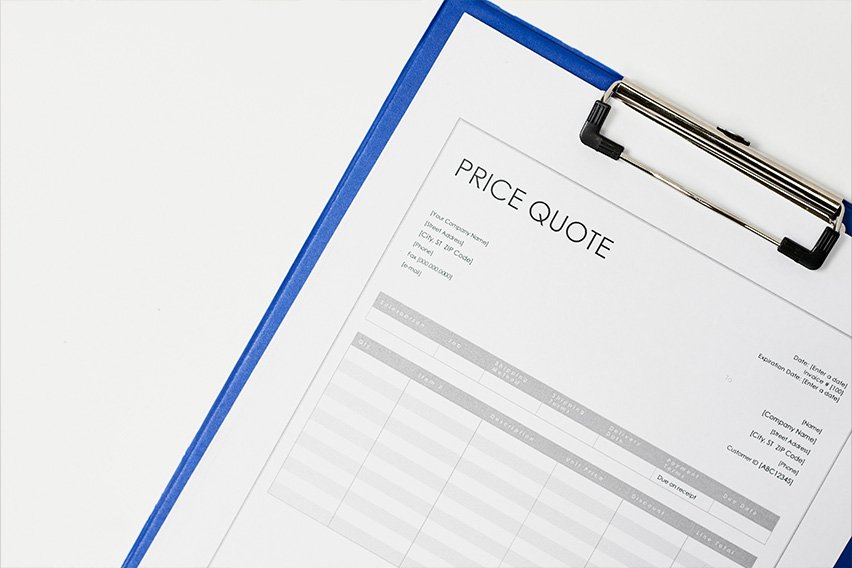How to Estimate Remodeling Jobs: A Pricing Guide

When it comes to remodeling jobs, don’t just base your estimates on what the competition charges. Home repair and Construction estimating is an involved process that involves taking into account many factors, including true labor costs, the cost of building materials, overhead, and profit margin.
If you take the time to price your jobs right, you’ll end up with healthy cash flow and a home repair business that’s built to last.
Here’s what we’ll cover:
- 6 Steps on How to Estimate a Remodeling Job
- How Much Does a Handyman Charge per Hour?
- How Much Does It Cost to Rewire a House?
- How Much Does a Plumber Charge per Hour?
- Take the Guesswork Out of Your Remodeling Project Estimates with FreshBooks
6 Steps on How to Estimate a Remodeling Job
In this article, we’ll go through 6 steps explaining how to estimate a remodeling job.
1. Compare Past Estimates
Take a look at your estimates for similar past projects. This will help you develop a preliminary estimate to share with the potential client. This can also help you figure out if it’s worth it to take on the job based on whether similar past projects were profitable.
The size of the home repair service will play an important part in comparing past projects with your current estimate. If your previous services were only for small jobs, such as replacing faulty downlight globes or repairing a dripping faucet, you wouldn’t compare that to more complicated electrical work.
Make sure that the location size is comparable, too, as that can have a large impact on the home repair estimates you’ll be providing.
If you don’t have much experience as a contractor yet, consider using estimating software. We’ve compiled a list of top home remodel estimating software in our post. Additionally, you can try a free home improvement cost calculator to get a general idea of what the project should cost.

2. Calculate Material Costs
Now put together a list of materials you’ll need for the home remodeling project. There are various ways to calculate how many materials you’ll need. One method is to use a building materials calculator.
There are also a variety of apps for contractors that will help you calculate material costs. A good cost calculator tool will help you calculate the amount of material you need to fill a certain volume, depending on the material type (concrete, brick, wood, etc.).
For a general contractor managing a lot of different tasks and responsibilities, these apps can be a huge time saver for estimating the project quickly and accurately.
3. Estimate Time Required
For accurate estimates, you must also determine how many hours the repairs will take. Small jobs like replacing light switches, hanging a picture, replacing a thermostat, or repairing a leaky faucet or garbage disposal should take no more than 1 to 2 hours, according to Home Advisor.
Medium-size jobs like repairing drywall, replacing a window, hanging a new door and hanging shelves should take 2 to 4 hours. And large jobs like installing a kitchen sink and other big plumbing jobs, wiring and electrical work, installing heating and cooling registers and repairing a wall, flooring or roof take at least 4 hours, if not a couple of days.
4. Calculate Labor Costs
Include labor costs in your price, even if you’re the only one doing the job. If you have an employee doing the work, make sure you factor all labor costs into their quoted hourly rate.
Using a labor cost calculator can be a lifesaver when it comes to calculating different types of employee rates, such as supervisors or site managers. Other factors, such as overtime billing rates or specialized labor, will also affect the final price estimate.
In order to properly account for your labor costs, you’ll also need to know how much workers’ compensation, benefits, bonuses, insurance, vehicles, and phones are costing you. You may be paying an employee $20 per hour as a remodeling labor rate, but after these extra costs, you may actually be on the hook for $35 or more per hour. Busybusy’s labor burden calculator will help you figure out how much it actually costs to maintain your employees.
5. Accommodate Specialty Costs
If needed, look into the cost of high-end or specialized materials needed to complete the job—particularly for kitchen and bathroom remodels. Always verify the pricing of these specialty items yourself, but be aware that by the time you actually order them, the price may go up. To protect your profit margins from these unpredictable price increases, mark up specialty items more than usual.
Using an estimating calculator here can be of great value as it will adjust the project details of your estimate according to price fluctuations. If the price of your specialized materials goes up or down, simply put in the different price and let your estimating calculator do the rest.
6. Add Your Markup
Knowing how to write an estimate for a job is certainly an art. Your estimate should give you a healthy profit margin and cover overhead costs. Part of this involves calculating the true cost of labor, as discussed above. It also involves accounting for other overhead expenses that may not necessarily result from the project at hand.
Don’t let yourself be caught unawares and find out that you haven’t made a profit from your remodeling job after the fact. It’s always best to err on the side of caution.
Here are some typical handyman expenses to consider when creating an estimate for your remodeling project:
- Monthly living expenses
- Health and liability insurance
- Tools
- Advertising
- Vehicle mileage and maintenance
- Website costs
- Office supplies
- Phone and internet
- Licensing fees
- Taxes: self-employment, federal income tax, state income tax
Your quoted hourly rate needs to cover all of these expenses, so consider setting your profit margins at 35% to account for these costs.
If you need to, try cutting down on your overhead costs to help you meet this number. Even calling your cell phone and internet providers to make sure you have the best rate possible can help.Small factors can often affect your final outcome. Doing the work to calculate overhead costs can have huge benefits down the road. It’s always best to give yourself a certain amount of wiggle room in your estimate, as unexpected factors can affect the final cost of the project.

Bonus Tip: Don’t Discount
You might think discounting is a great way to edge out the competition, but in the long run, you’ll be doing your home repair business a disservice. Adding discounts makes you look desperate, undercuts your professionalism, and hurts your cash flow.
Instead, try raising your prices to increase your cash cushion. A price increase of even 0.5% probably won’t be noticed by your customers, but your bank account will thank you.
If a potential customer pressures you for a discount, tell them you’ll review the numbers and get back to them. If a discount isn’t feasible for you, try approaching them with a decrease in project scope instead. This means you’ll need to pick up more jobs, but at least you’ll be making the profit you need.
Look at your preferred payment options for more ways to cut costs. Some credit card payments require higher surcharges. You can pass on these charges to the customer. Read our guide on How to Charge Credit Card Fees to Customers to learn more.
You shouldn’t be selling your services based on price alone, but on the value you provide. Being reliable and offering excellent customer service will win you more happy customers than a low price will.
How Much Does a Handyman Charge per Hour?
In the U.S., a handyman charges $60 to $125 per hour on average, plus the cost of materials, according to HomeAdvisor. At the end of the day, however, the hourly rate will ultimately depend on where you’re located and how experienced the handyman is.
HomeAdvisor has a handy guide to how much your project will cost by ZIP code.
How Much Does It Cost to Rewire a House?
Taking into account materials and labor, it costs about $2 to $4 per square foot to rewire a house, according to Angi. The final price will vary based on how old and how large your house is and how easy it is for the electrician to get at the old wiring. To ease the process without compromising quality, you can utilize electrical estimating software. We have compiled a list of the Best Electrical Estimating Software that can help you obtain accurate and quick estimates.
How Much Does a Plumber Charge per Hour?
A plumber typically charges between $45 to $200 per hour in the U.S., according to HomeAdvisor. The total job cost is usually between $175 and $450 for typical jobs like repairing bathtubs, sinks, toilets, or faucets. If the plumber charges a flat rate, this is usually $300 on average.
Take the Guesswork Out of Your Remodeling Project Estimates with FreshBooks
If remodeling projects are your business’s main source of income, it’s especially crucial to estimate your remodeling costs accurately. Otherwise, you risk the viability of your venture.
That’s why it’s important to have a contractor estimate template you can use for every potential project that comes your way.If you’re looking for the best estimate template for your contractor business, the FreshBooks online estimating software makes generating and sending estimates easy. Plus, you can quickly convert them into invoices when the job’s done.
RELATED ARTICLES

 What Is a Price Quote? An Introduction for Small Businesses
What Is a Price Quote? An Introduction for Small Businesses What Is a Business Proposal? A Simple Definition for Small Businesses
What Is a Business Proposal? A Simple Definition for Small Businesses 7 Simple Steps to Write a Business Proposal | A Guide for Small Businesses
7 Simple Steps to Write a Business Proposal | A Guide for Small Businesses Create a Quote in 8 Simple Steps: A Guide for Small Businesses
Create a Quote in 8 Simple Steps: A Guide for Small Businesses How Can You Convert an Estimate to an Invoice
How Can You Convert an Estimate to an Invoice 5 Estimate Terms and Conditions for Your Small Business
5 Estimate Terms and Conditions for Your Small Business